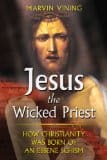 Jesus the Wicked Priest: How Christianity Was Born of an Essene Schism, by Marvin Vining
Jesus the Wicked Priest: How Christianity Was Born of an Essene Schism, by Marvin Vining
Bear & Company, 9781591430810, 243 pp (with indexes), 2008
The topics of the origins of Christianity and their relationship to the Essenic community as portrayed in the scrolls discovered around Qumran in 1947 and afterwards are still being debated more than sixty years after first coming to the attention of the world. There have been hundreds of books written – scholarly and popular – which have been praised, condemned, and ignored. Why review another book on this theme? Because this author makes an effort to present his premise in terms understandable by the “common man.”
While his approach to, and understanding of, the information contained in the scrolls and its application to understanding Christian origins is definitely in the minority (or “dissenting”) camp, it has the advantage of being couched in non-academic terms. By the same token, however, it suffers from reliance on personal opinion and interpretation. He is, at least, honest enough to acknowledge the work of his predecessors, even as he picks over their work to decide what he can cite to bolster his arguments.
Unless the reader in intimately familiar with Judeo-Christian writings of the first few centuries of the Common Era it may be difficult to assess the validity of some of the arguments put forth by Vining. Still, information is presented which appears to show the inter-connectedness of religions world-wide. And he does make an effort to stress the message OF Jesus as opposed to the beliefs ABOUT Jesus; and that is an effort to be encouraged.
Vining, at least, is honest in his picking and choosing which works of his predecessors he accepts and which he rejects, even if the basis for such acceptance or rejection appears to be personal belief rather than something more concrete and provable.
Ultimately, when dealing with matters of faith (which religion is) personal belief is the final validation of “official” belief. Many people pay lip service to a religion, with nothing more to bolster it, while others believe “heretical” thoughts based on personal experience.
While this is a book aimed at a Christian audience, it does offer some perspective on Pagan beliefs in the early Common Era. Whether or not you find it useful in your own understanding of Christian origins, it should encourage an open-minded approach to religion in general.








